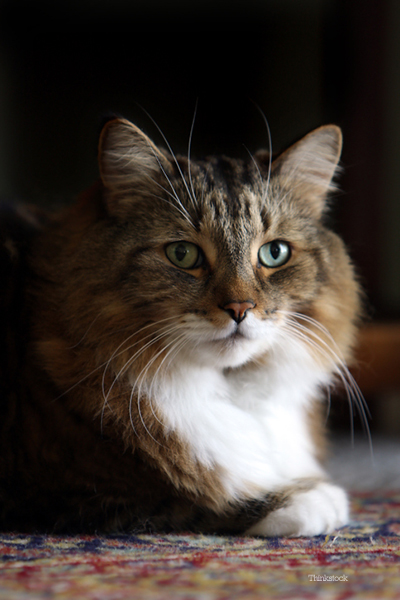 Heart disease is fairly common in cats, but some cats live many years with the disease before exhibiting signs while others never do. In senior cats, heart disease is typically acquired (as opposed to congenital or present at birth) and can be secondary to other illness like high blood pressure, heartworm infection, thyroid disorders or due to diseases of the heart valves (which are more common in dogs) or most commonly a primary cardiomyopathy (heart muscle disease).
Heart disease is fairly common in cats, but some cats live many years with the disease before exhibiting signs while others never do. In senior cats, heart disease is typically acquired (as opposed to congenital or present at birth) and can be secondary to other illness like high blood pressure, heartworm infection, thyroid disorders or due to diseases of the heart valves (which are more common in dogs) or most commonly a primary cardiomyopathy (heart muscle disease).
Diagnosing feline heart disease
If so many cats can be asymptomatic for heart disease, how do you know if your seemingly perfectly healthy acting senior cat has it? Certainly you could always run every test on every cat. And you might actually do that if you owned a breed of cat that is especially prone to serious heart disease (like a Maine Coon or a Ragdoll cat for whom a genetic test exists specifically for hypertrophic cardiomyopathy), but that is not really practical for all cats. Instead, usually, the process begins with your cat’s routine physical examination when your veterinarian listens to your cat’s heart and lungs and feels her pulse.
An audible murmur can indicate the presence of heart disease — stressing the ‘can’ — because studies have shown that up to 50% of apparently healthy cats have audible murmurs, but many of those cats do not have heart disease. This is because especially in cats, murmurs can be functional or physiological (not pathological) occurring with other conditions like thinner blood from anemia, altered flow from hypertension, or with an increase in heart rate from fever or stress. To complicate matters further, cats without murmurs can also be found to actually have heart disease.
An abnormal/irregular rhythm can also be predictive for heart disease – as can any indication that your cat is developing congestion/fluid accumulation in or around her lungs. So remembering that not hearing any abnormality does not entirely rule out heart disease, routine physical examination is still the primary method by which we identify which asymptomatic cats need more extensive cardiac testing.
Additional heart disease testing can include:
- Chest radiographs ("x-rays") that can provide an indication of the overall size of the heart and the larger blood vessels but can also help to indentify fluid accumulation in the chest or in lung tissue indicating early congestive heart disease.
- EKG tracings are primarily indicated if your veterinarian appreciates an irregular heart rhythm or pulses that don't match the heartbeat.
- Thorough blood testing is important to rule out other primary causes for murmurs or heart disease as mentioned above and also becomes quite valuable if your cat does end up needing medical treatment.
- Blood pressure monitoring is performed to determine the presence of hypertension (high blood pressure).
- Ultrasound (echocardiography) is a definitive test. Unlike radiographs that only let you evaluate external dimensions of the cardiac silhouette, ultrasound provides the ability to see inside the heart, to measure wall thickness and chamber volumes, and also to really evaluate the function/movement of valves and contractions in terms of strength and direction of blood flow. It can even be possible to identify the presence of clots or heartworms via ultrasound.
- If ultrasound is not not readily available to you or it is not financially feasible there is also a blood test for a cardiac biomarker (Cardiopet NT-proBNP) that can be run to further evaluate the risk/likelihood that heart disease does exist. Finding an increased value at the lab or an abnormal result tested patient side suggests that the heart is under increased stretch or strain, and really should be further investigated.
Why should I test my cat for heart disease?
You may wonder, though, why test? Why worry if your cat is not showing any symptoms associated with heart disease? The problem is that the early signs of heart disease can be quite subtle. Decreased activity and weight loss may easily be interpreted as ‘normal’ for your older, aging cat. In addition, establishing baseline data (blood work, verified lack of lung congestion and heart size) when your cat is not sick can be helpful later when it becomes necessary to judge the significance of any changes that occur if/when she does become symptomatic. Also, there are certain medical procedures (like intravenous fluid therapy or anesthesia) that can precipitate the onset of overt cardiac disease in the previously ‘normal’ cat.
Lastly, if you are aware that your senior cat has underlying heart disease, you can be more alert at home to any changes that might indicate progression of the disorder. You can determine asymptomatic baselines for resting respiratory and heart rates so that if those rates increase you can consult your veterinarian. Likewise if your cat does become less active or has increases in respiratory rate or effort, you may be more likely to seek advice. After all, knowledge is power, especially since your cat cannot communicate for herself.
If you have any questions or concerns, you should always visit or call your veterinarian -- they are your best resource to ensure the health and well-being of your pets.
